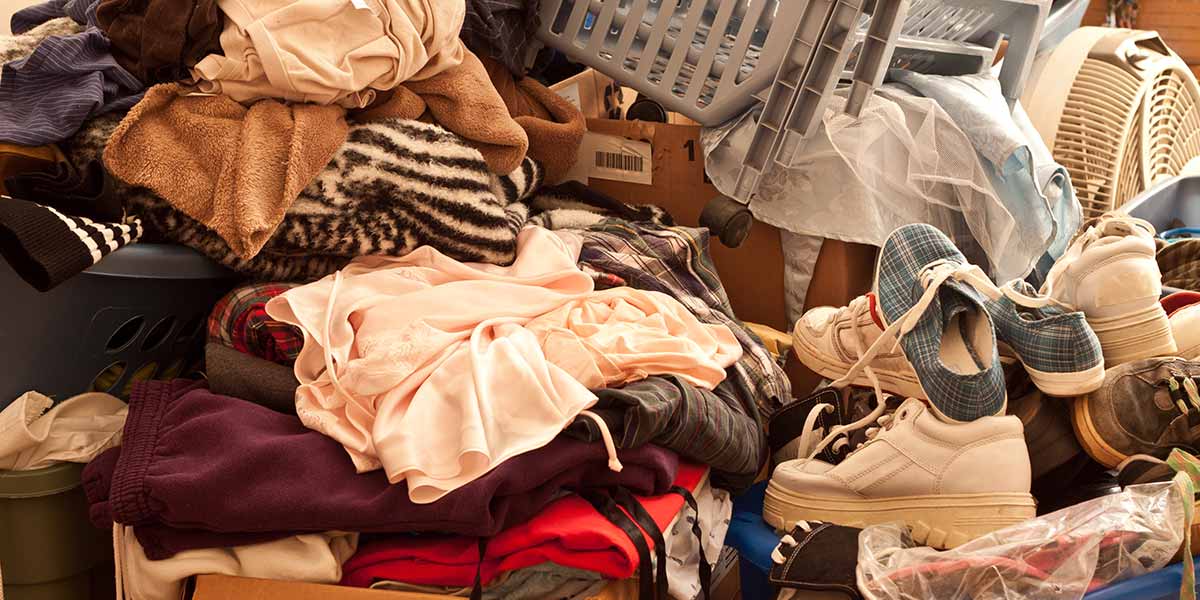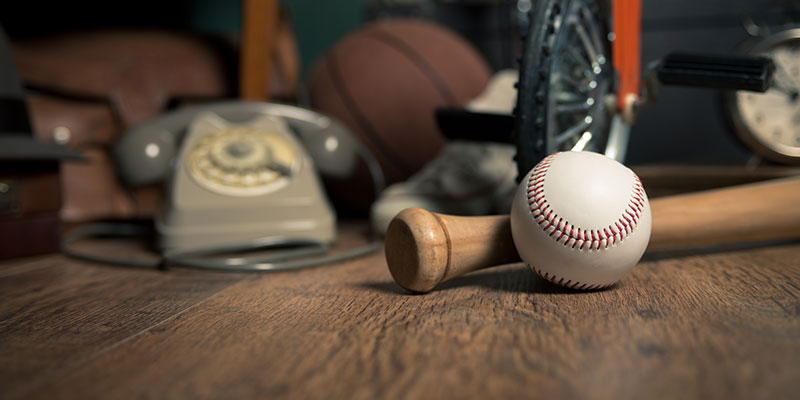
No matter how diligent you are, clutter easily piles up. Whether it’s an attic that has become a box warehouse or years of living in a house catching up to you, sometimes you need to hit the reset button.
Just how do you clean out something as big as a home without being overwhelmed? We’ve asked the experts at Becoming Minimalist, Get Organized Already, The Joyful Organizer and The Organizing Professionals for their tricks to plan a successful home cleanout.
You don’t build a home without blueprints and you wouldn’t take a road trip without a map. Cleaning out your home is no different. As you get ready to start, it’s important you take the time to step back and figure out why and how you’re decluttering your home.
Without a goal in mind, it’s hard to stay on track. Before you start sorting and tossing things, take a moment to consider why you want to clean out your home. Are you hoping to sell your home or maybe you’re helping an older loved one cut down on their possessions? A clear sense of purpose goes a long way to keeping your project moving.

“If you get on a treadmill, you have a mileage or time goal in mind. You should have the same goals with organization. What are you trying to accomplish? Why are you getting organized? Keep these goals in mind as you move along your project.”
Bonnie Dewkett | Founder, The Joyful Organizer
Spending a few minutes in each room of the house will pay off in the long run. Note big items that you want to get out of your home, which things will find a spot in a different room and a general gauge of how much work will need to be done — both overall and in specific rooms.
You don’t need to do a full sort at this time or even start making a list or marking items. Taking inventory is strictly to help you mentally prepare for the project and create a plan.
As you’re noting the items you want to toss, think about how you’re going to get rid of them when the decluttering begins. There are plenty of disposal options, but the right one for you depends on how much you’re tossing and the time you have available. The key ways you’ll get rid of bulky items come down to two categories: donate or toss.
If you want to donate items, research your options before you start. Most centers take a wide range of items, but you’ll want to reach out to make sure they are currently accepting yours.
As for tossing items in the trash, your options are curbside disposal and renting a dumpster. You’ll want to check with your curbside service to make sure they offer bulk trash pickup and ask about any restrictions.
If you have a lot of items to toss, renting a dumpster is often the most time-efficient option to get rid of everything at once, from boxes of knick-knacks to old furniture and appliances
A room-by-room plan and a timeline are the keys to any home cleanout. According to Dewkett, you need to keep yourself from becoming frustrated and disheartened during your cleaning. “A whole home cleanout can be overwhelming,” Dewkett said. “You need to be clear on your boundaries and time frame. Do one room at a time.”
Take what you learned during your inventory time to create a cleaning plan. Intertwine your cleaning schedule with your work and personal schedule to balance your time. If you know you have a busy schedule coming up in a few weeks, don’t plan on working on the most cluttered room of your home that week. Instead, tackle a room that only needs a few 10-minute sessions to declutter.

“We advise our clients to schedule plenty of time on their calendar and pace themselves. Don’t expect to clean out your home in a single weekend. Carve out time on your calendar just as you would schedule an appointment with your doctor.”
Janet Bernstein | Founder & Principal, The Organizing Professionals
There’s no cookie-cutter decluttering plan that’s going to work for you. Your cleaning schedule needs to be customized to your needs and your time frame. You can do this yourself, but there are also helpful apps available that can aide you with creating a cleaning plan.

“Decluttering an entire home can be an overwhelming task when you think of it that way. Many people find themselves paralyzed to even get started because of the enormity of the project — especially if you’ve lived in the same home for several decades. The key to planning a whole home cleanout is to break your project into single rooms, moving from the easiest pace in your home to the hardest.”
Joshua Becker | Becoming Minimalist
To start cleaning out a room, get rid of things that are obviously trash. Broken things, duplicate items and objects you haven’t touched in a long time are all prime candidates to be purged in this phase.
Don’t stress about making tough decisions on what needs to be thrown out at this point — just take an initial sweep. In the next step, you’ll get a better picture of the overall project and it will help you make those tough decisions.
If you’ve got a few rooms in a row coming up that you plan to clean out, consider renting a dumpster for this step, allowing you to toss the trash from all those rooms as you work on your schedule with our flexible rental periods.
With a fair amount of trash out of the room you’re working on, you now have some extra space to categorize. Sort what’s left in the room into three piles: keep, donate and store.
If you find yourself becoming overwhelmed by this process, there are a few things you can do to help keep yourself energized and engaged:

“Having a few goals for your space will keep you motivated. Write your goals on a piece of paper and tape it to the wall where you are working. After an hour (or many hours) of going through items, you’ll get side-tracked and that paper will be a grounding reminder of why you are doing this hard work.”
Nonnahs Driskill | Founding Organizer, Get Organized Already
Additionally, this step tends to be the hardest because you’ll be forced to make decisions on items that you may have an emotional attachment to. While these decisions are personal, Becker offered some advice on how to approach sentimental items: “The most important step is to recognize where those emotional attachments are stemming from and if they are healthy motivations or not.”
Sometimes these items are holding you back from moving forward in life. Cleaning them out can be a good time to think about the past, remember the good times, make peace with what has happened and then part with the item so that you can move forward.
Bernstein provided a few mantras that she has used with her clients to help them determine if an item is something they really need to hold on to:
Ultimately, the decision on each item is up to you. No one can tell you what you should and should not keep. However, that means you need to be honest with yourself when making your decisions.

“There isn’t an easy ‘2-step life hack’ to overcome emotional attachments. This takes work and self-reflection. But in the long-run, it’s the work you need to do for yourself and the people you love the most.”
Joshua Becker | Becoming Minimalist
With everything sorted, you should have a few piles of items that need to be stored or donated. Now’s the time to get that stuff out of your home. Take as many trips as you need to get the items to their final destination. Second-guessing is natural, particularly for items you are attached to. However, if you felt strongly enough to get rid of it, you should trust that instinct.
Pro Tip: While donation centers like Goodwill and The Salvation Army are fantastic options for taking multiple types of goods, don’t forget about local charities.
At this point, all that should remain from your decluttering adventure is the keep pile. Go ahead and put away the stuff that will stay in the room. It’s the items that will be housed in a different room that could be problematic.
If the destination room has already been cleaned out, get those items put away. If you have yet to declutter the room where an item is heading, let it stay where it is until you get to that room. However, make sure whatever you want to keep is not tucked away — keeping it where you see it will help you remember to move it.
Keep in mind, it's going to take some time to remember where you put all of these items. Don’t worry. That’s perfectly natural and expected.

“To the extent possible, give every item a home. If this is a new practice for you, use post-it notes to remind yourself where the batteries live, or where the coffee mugs moved to. Put the notes on the outside of cabinets and drawers. Take them down once everyone in the house is familiar with the new system.”
Nonnahs Driskill | Founding Organizer, Get Organized Already
For those wishing to use more than just curbside disposal to throw out junk, the national average rate for renting a 20 yard junk dumpster is between $287 and $625. If you opt for a junk hauling service, the average price range is $136 to $361. However, a full truckload often costs between $400 and $800.
For those doing a cleanout themselves, the cost can be as low as any donation fees that you may accumulate.
The quickest way to empty a house is to either hire a junk removal company or rent a dumpster.
A junk removal company will get your items out of the house in a matter of hours, but you’ll need to have everything prepared before the team arrives and let strangers into your home. You would have to incorporate any donation or storage you would like to do after the fact.
With a dumpster rental, you control your own timeline. You can get the project done in a matter of hours or in a week or so. Plus, you can easily get items out of your home as you’re sorting. It’s all up to you.
Perhaps Becker said it best: “The more we recognize the benefits of owning less, the easier it is to keep our homes from filling back up again. The more we sense peace and calm and freedom in our physical spaces, the less likely we are to clutter them up again.”
With a cleaned out home and an updated mindset, the possibilities for what’s next are endless.
Not sure what to do with your newly cleaned space? Maybe it’s time to do some home upgrades or finally finish off a room.


